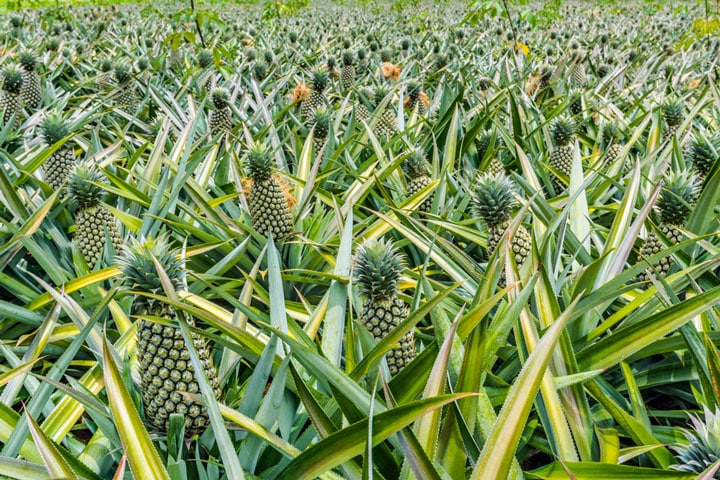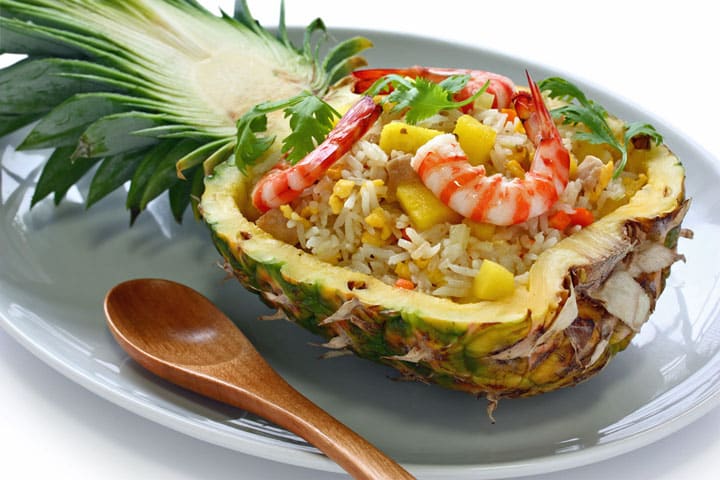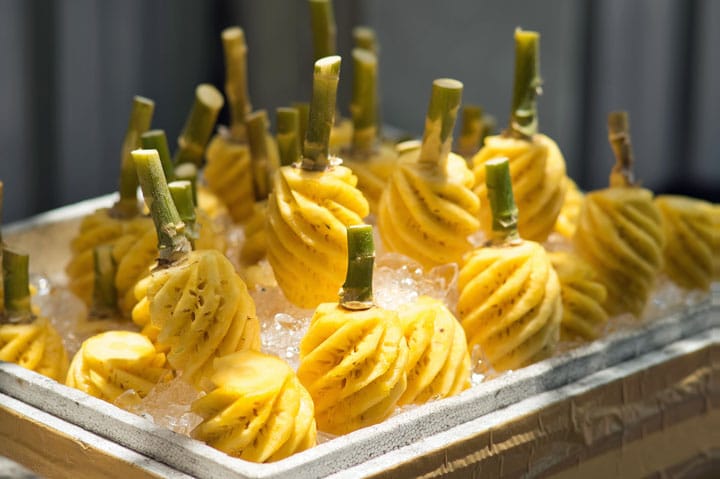Pineapple in Thailand
Every day you see the numerous motorized or non-motorized carts with fresh fruit driving through the city. In a glass or plastic display case, the fruit is kept cool by bars of ice and if you feel like it, the saleswoman will prepare a nice portion of bite-sized fruit chunks for you.
Different fruits are offered, but I always choose watermelon and pineapple. Around four or five in the afternoon, when you slowly but surely get hungry again, such a portion of fruit gives you a wonderfully fresh boost. I leave the supplied bag of sugar or pepper mixture for what it is, the Thai can use that.
Dutch food
Of course we also know pineapple in the Netherlands, in some supermarkets and specialty shops it is for sale fresh, but we mostly use canned pineapple. A few chunks on a pizza and the pizza is suddenly called a Hawaiian pizza. Pineapple should be in a fruit salad and pineapple is also a welcome addition to many ice cream recipes.
More and more we see pineapple being used in “hot” dishes. How about, for example, a sauerkraut dish in which pieces of pineapple have been processed? There are also many recipes and dishes in Surinamese, Indian and Antillean cuisine in which pineapple plays a role. On the internet you will find countless sites with beautiful recipes.
Thai food
Also Thailand knows many dishes with pineapple. Think in the first place of the well-known “kaeng khua” dishes, spicy curries with a sweet and sour taste. This dish comes in many variations, such as a very old one, made with turtle meat. This turtle meat is hardly used anymore and was replaced by pork. However, the Thai still call the dish "kaeng khua muu taphap nam", pork / turtle curry. A variation on this is the use of mussels or horseshoe crab eggs.
Nowadays there are a lot of "pad prio wan" salty and sour stir-fries, but an "old-fashioned" dish here was made from "taeng lan", a large type of cucumber. This is hollowed out and cut into pieces, then mixed with paprika, pineapple and pork and fried. Then the dish was flavored with brown sugar, “nam pla”, and sometimes tamarind juice. Nowadays, the pork in this dish is also replaced by other types of meat, fish or shrimp, and tomato, corn or carrots are also added.
Origin and growing areas
Pineapple is not originally Thai. It was once brought to Europe from South America by ships of Columbus, and then the pineapple spread over large areas in other parts of the world, including Asia. In Thailand it once started in Sri Racha in Chonburi province. The first commercially grown pineapple had the name "Batavia", which suggests that the VOC may have introduced the pineapple to Thailand. The Batavia (also phonetically spelled Pattawia) is a large pineapple with yellow, very juicy flesh. Moreover, very sweet, so the Thai loved it.
Pineapple cultivation has slowly but surely moved to other provinces, with Prachuap Khiri Khan being the most important. The Batavia has also changed its name and is now called the Sri Racha pineapple.
Varieties
There is a smaller type of pineapple, very suitable for eating fresh, but less suitable for use in dishes. They were first grown in Phuket and for that reason it is also called the Phuket pineapple. They are smaller than the Sri Racha variety and the flesh is crunchy, not too juicy, and the taste has a nice balance between softness and sourness.
Subsequently, a new variety was developed in Chang Rai province, the “Nang Lae” pineapple, crispier and sweeter than the Phuket pineapple. However, the rising star among Thai pineapple varieties is a new variety, mainly grown in the province of Uttaradit, the “Phu Soi Dao” pineapple. Also sweet and crunchy, but thin skin and less deep “eyes”.
Manufacturing
The vast majority of pineapples grown in Prachuap Khiri Khan are supplied to the processing industry by contract growers. The American company Dole is the largest producer of canned pineapple, but there are several factories where pineapple juice or canned pineapple is produced. Just as in other agro-industries, such as rice, dairy, maize, fish, etc., the pineapple industry does not excel in excellent working conditions and excellent prices for pineapple growers. Due to the low wages and low prices for the growers, Thailand is the largest producer of pineapple products in the world. The Philippines and Brazil are also among the top producers.
Text was used from an article about pineapples in the Bangkok Post





If you put the top of the pineapple in a glass of water, it will grow new roots and grow again.
I consider myself lucky to live near Pranburi, where the sapparot (pineapple) Delmonte factory is located.
And I regularly get a pineapple from the neighbors, it can't get any fresher!
The cuttings are placed in the ground dry, without roots.
Where is the factory then? I know Dole west of Hua Hin along the Pa La U road.
I can't find anything from Del Monte.....
Remains a nice piece of fruit, if I buy one myself from the supermarket, it sometimes falls short of late.
Never forget the man on the Rotterdam market roaring: “PINEPINE WITHOUT JACKET”. Also fresh and completely clean in 1 pull of the handle. I think the Thai from the fruit stand gets a headache from all that lost pulp.
Pieces sound tastier than chunks, with chunks I think of something pressed together. I think kibble only grows in the throat, but nice info further 🙂
Those from Phuket are very tasty for a healthy snack.
Gringo
Nice article. I didn't know that so many different types of pineapple were grown.
I always thought a pineapple is a pineapple, but apparently that family is bigger than I suspected. Thanks to your article I now know better.
Not that I'm going to try all those varieties right now because I might be one of the few who doesn't like pineapple.
We live in Chaiyaphum, and grow the Sri Racha.
Yes, a very juicy and sweet pineapple. "maknat" in Isan.
Too bad, because of old-age sugar, my doctor has forbidden me to eat much of it. The sweetness is determined by tapping the pineapple with your finger as if you were shooting a wad. The duller (less) the sound, the sweeter the pineapple.
In the Netherlands I always peeled them much too sparingly, and then it took a long time to pick out the eyes. My wife is so done with that big cleaver of hers.
Economical cutting is therefore not necessary if the Delmonte size 1.8 THB gives the kilo.
That is why you now see a lot of plantations where you put rubber trees between the pineapples, to switch to rubber in the long term. This must be done with care, as after three years you can no longer put pineapples under the trees, as the foliage then becomes too dense.
After that it is another 5 years of waiting until the trees are big enough.
Many Thais have not yet realized that they have no income from that country for those 5 years.
Hans
Dear Hans,
You also use the same tap with melon (learned from my wife).
Sometimes the simple things are more well thought out than you might think555.
Yours faithfully,
Erwin
Hans
I also live in Chaiyaphum and have tried to plant pineapple many times. through the known process. take the head off and put it in the ground.
Grows a little and then stops.
I live 10 km from the capital to give you an idea, so not mountainous, where it will probably work.
You talk about Sri Racha, do you have more info about that?
Regards
Georges
Nice recipe: Pineapple with coconut
Required: 1 pineapple, sprigs of mint, 50 grams of butter, 75 grams of grated coconut, 75 grams of icing sugar, 2 tablespoons of flour, 2 egg whites.
Preparation: heat the oven to 175 degrees. Line a bathtub with baking paper. . Melt the butter and let cool. Mix the grated coconut with the icing sugar and flour with a mixer and beat in the egg whites and still liquid butter. Spoon a spoonful of this batter onto the baking paper and spread it into a circle. Bake the round cookies for about 7 minutes until golden brown. Take them with a palette knife from the spa and fold them directly over a bottle. Let cool and bake the next series. Cut the flesh from the pineapple. Cut into cubes and mix with the mint cut into strips. Serve with some cookies.
Do you want to see pineapple fields? then drive to the golf course called Pattawia (indeed the Thai name for Siracha pineapple). This is located on road 331, 4 km further up Treasure Hill from Rayong
I suddenly wonder if Pattaya isn't also a corruption of Batavia 🙂
The best pineapples in the world are said to come from Prachuab Kirikhan because the soil there is ideal. You will see countless pineapple fields there on the way to the natural border with Myanmar. In our countries also canned pineapple from over there.
A Belgian company, “Greenyard” is currently lurking to buy the now American company.
More info:
http://www.landbouwleven.be/2267/article/2018-01-22/dole-nog-steeds-vizier-greenyard
I miss a very important one with the recipes with pineapple.
What did you think of 'Sweet and sour'?
Just happened to make it tonight and we thought we were back in Thailand, where unfortunately we can't be this year due to serious illness of my wife.
Poison bombs are in Thailand because of all those pesticides absorbed by the fruit.
I stay off it.
No, then a nice melon in Thailand, same sheet and suit.
You have to eat fruit here if it comes from Australia, New Zealand or Europe.
And then hope it will be okay.
Every company that wishes to export to “The West” will have to obtain a food-safe certificate: BRC, IFS and/or FSSC 22000. In doing so, the pesticide residues of the used raw materials resp. even the soil, from which the fruits come.
The EU Member States have a database where anyone can request information, including found – too high – values of pesticides. see https://ec.europa.eu/food/safety/rasff-food-and-feed-safety-alerts/rasff-portal_nl respectively. https://webgate.ec.europa.eu/rasff-window/screen/search
Authorities in the Member States receive immediate warnings. The UK is outside this database after leaving the EU, and therefore no longer receives any information.
The article here is about companies that export pineapple.
Just buy a pineapple on the market in Thailand: that is of lesser quality.
My wife has 40 rai Pineapple, and she does not use any pesticides, as the pineapple has few enemies. The only ones are the field mice that gnaw on the sweet fruits. If they ate the whole pineapple now, it wouldn't be a problem, but it's just taste, so we have a large number of eaten pineapples. These are the tastiest, but we can't sell them. And the voles are difficult to eradicate.
Are there more people who often get an allergic reaction when they eat pineapple in Thailand.
I remember severe swelling of the palate, mouth, tongue and lips
when I lived in Nongkhai.
That also happened to me in Korat.
Don't know where that pineapple came from then.
Some explained that it came from spray products… but I don't know.
Perhaps of the species?